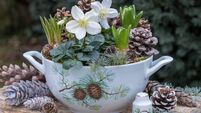Wooden it be nice
A simple store, a much worshipped man-cave, the shed is the outdoor building to beat all others for economy, looks and downright usefulness. Wood is a traditional material that sits perfectly in horticultural surrounds. Follow our simple tips to select an ideal timber retreat this summer.
Wooden sheds come in a variety of sizes and designs, and whatever size you think you need, once settled in, you’ll dream of a couple more metres to clog up with horticultural endeavours. Buy the largest quality shed you can afford to meet your growing needs. Forest Stewardship Council (FSC) labels are the gold star of certification for sustainable timber. Larger sheds, especially in log forms, are marketed as outdoor living spaces, but go for practicality above overt cuteness. Slender overhung ‘verandas’ offer eye-watering charm but little practical benefit, bar setting the scene for an oversized Bavarian cuckoo clock, and block the door against mowers.
Wider, double doors and even a ramp are useful if you have a large mower or weighty equipment to stash inside. Window configuration and sizing is key, and obviously, place openings to the aspect to suit your site. The potting shed features a large area of glass for starting young plants. As a timber hybrid of a glasshouse and shed it is obviously not as secure as a more blind sided building. If you want to save money, and have basic carpentry skills, you can assemble your own shed from supplied panels on a pre-prepared base, but many homeowners vouch for an installation service or have the finished shed craned into position. Ensure the delivery van has adequate access to drop off a complete shed. Adding electrics costs more, but increases the usefulness of the shed.
Aside from a log shed, built upward from interlocking wood boards, most sheds are timber stud panels clad on the outside and fastened together at the corners to make the building. Timber cladding comes in rebate ship-lap, T&G cladding, rebate weatherboard, and feather edged overlap (attractive, affordable but draughty and high maintenance).
Extras include double doors for storing larger machinery and tools, alternative roofing materials (felt is generally standard), extra windows, greater than standard height and a finished floor. You can also opt for an insulated shed with fibreglass stuffed panels and boarding to the inside walls, lifting the spec to more comfortable year round use.
When buying, make a Hercule Poirot/eyeball to splinter investigation of the show sheds. Chances are theses have been sitting out in all weathers and had customers toeing the floorboards, and pulling at the cladding for some time. Forgetting size and design, how are they holding up? Is the cladding and frame peppered with large knot holes? These can signal a lesser grade of wood, and as the knots shrink and fall out they can compromise the strength of the frame and introduce areas for rot to take hold. Are there irregular gaps between boards, bows, bends, odd angles, protruding nails or screws and split timbers? It’s worth taking a closer look and selecting the one you are happy with.
The number of upright timbers in the frame is a good indication of a quality shed that will last the course. Five along the sides and four along the short lengths is about right for a standard starter model of 3m x 2.4m. All hardware should be galvanised whether you buy your shed completed or go DIY. Take a close look at the hinges, locks and handles of the door. Is it well fixed and secure? Does it swing and lock up nicely? Roofing felt should be of a good thick grade and attached with the correct tacks. Eaves should overhang the building by a minimum of 2 inches.
Standing inside the shed, give the roof a shove on one side. Does it move the other side? It shouldn’t. The apex roof gives maximum headroom, so if you’re using your shed for hobbies or as an escape from the domestic uproar, consider going ‘housey’ in the roof structure. The pent roof has one gentle slope and rafters might seem annoying to the eye, but they serve as props for fishing rods, hanging points for drying bulbs and much more, so don’t be put off if your head still skims under them.













